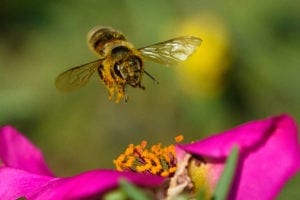Bees serve a critical role in nature. They gather pollen and nectar from the flowers of many plants, like apple trees, melon vines, broccoli plants, sunflowers, and more.
These flowers and trees have sticky pollen, and when bees land on the flower seeking nectar, the pollen sticks to the bees. When they fly to the next flower, the pollen drops off and the flower is pollinated. This cross-pollination allows trees and plants to bear fruit.
The amazing relationship between honeybees and flowers is a wonderful example of how nature rewards collaboration. The sticky particles of some forms of pollen are too heavy to be pollinated by the wind. They need the bees to spread their pollen to other flowers.
Nature actually designs bees and flowers to be attracted to each other. Flowers give off pheromones and chemicals that help bees find the flowers that have the nectar they need. The flowers use nectar to attract the honey bee and the fuzzy little bodies of bees collect the pollen while they are seeking out nectar. It is as if there is a key seeking a lock that it is designed to open. These lock and key relationships are found all over nature.
Organizational Bees as Pollinators of Ideas
Our organizations rely on ideas to stimulate innovation. Ideas flow through relationships, much like the relationship between bees and the flowers they pollinate. If we want to facilitate innovation in our organizations, we might want to seek answers to these questions.
- What conditions need to exist for people to widely share ideas with other team members and organizational staff?
- Is there a version of cross-pollination in an organization? For example, does innovation take place when ideas cross departments and divisions?
- Who in our organization are great pollinators of ideas and what do they do?
- What do pollinators of ideas seek that motivates them to share ideas? What is their “nectar”?
If we understood what this looks like in our organization, we could encourage it, reward it, and strengthen this behavior. The research is clear that there is a positive correlation between ideas and innovation.

A Word of Caution – Why Consciousness Matters in the Spread of Ideas
In nature, pollination is designed as an instinctual response in a mutualistic relationship. When bees don’t find nectar in a flower, they don’t continue to seek out that specific plant. That behavior is embedded in nature’s design of having form fit function.
The function is finding nectar that feeds the bees survival and the form is the flower. If the flower doesn’t serve the bee’s purpose, the bee finds a different flower.
In human beings, we can be attracted to habitual ideas that we continue to pollinate across our organizations and even between organizations. For example, board members who serve on corporate or non-profit boards learn how to govern an organization. When they move on to serve on another board, they take their ideas of how to govern with them. Leaders do the same. They take their ideas on leadership from one sector or organization and assume they will work in another.

The problem with this kind of thinking is that some ideas are connected to old ways of working or no longer fit the changing environment in which the organization exists. Leaders who think their leadership practices in one organization will be a perfect fit for their new organization miss a critical reality of living systems; context matters.
Living systems are unique. We can scale ideas across organizational contexts, but they can’t just be replicated, they must also be adapted to the unique context of the new organization.
Consciousness, Mindfulness, and Curiosity
When we insert a reflective curiosity about the context of our ideas and habits, we take time to learn about the context of the organization or board. This pause allows us to understand the uniqueness of the organization, its culture, and the disruptions that are happening to it from the external environment. Only then can we see if our ideas fit within the purpose and function of the organization.
We will also understand when our ideas, like our way of leading or governing, need to be let go of so we can learn how to lead and govern more effectively. I.e. if one flower isn’t working for your organization, leave it alone and move to the next one.
Dr. Kathleen E. Allen writes a blog on leadership and organizations that describes a new paradigm of leadership that is based on lessons from nature and living systems. She is the author of Leading from the Roots: Nature Inspired Leadership Lessons for Today’s World (2018) and President of Allen and Associates, a consulting firm that specializes in leadership, innovation, and organizational change. You can sign up for her blog on her website: www.kathleenallen.net







Bees are a wonderful analogy for the process of human feedback. Interesting to consider the many ways (some subtle) in which that process can be disrupted. Here’s evidence of a disruption to bees caused by chemical interference to bee gut bacteria – https://www.theguardian.com/environment/2018/sep/24/monsanto-weedkiller-harms-bees-research-finds?utm_source=esp&utm_medium=Email&utm_campaign=GU+Today+USA+-+Collections+2017&utm_term=286411&subid=22517821&CMP=GT_US_collection
Perhaps this is analogous to rapidly disseminating social media memes disrupting the sincere, honest human communication necessary for feedback to be given and heard.
Loved your recent pollinator comments, Kathleen. I will weave some of them into my director’s comments at our grant round board meeting on Oct. 4th.
Well wishes!
Nancy
Ps I purchased 10 copies of your new book to hand out to the board and staff for winter holiday gifts. They will as thrilled to receive them as I will be to gift them. Can’t wait to read my copy, as well.